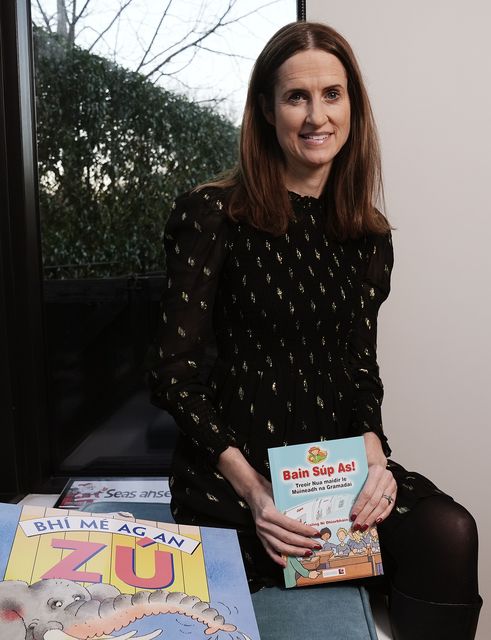Researchers in Dublin have produced a report showing the benefits of a plurilingual approach in teaching Irish in primary schools, particularly children whose first language is not Irish or English.
The Dublin City University (DCU) project said it promotes cultural diversity in schools by encouraging children in English-medium primary schools to draw on all of their linguistic knowledge.
Ireland is a multilingual country with more than 200 languages spoken daily. Polish is the most commonly spoken outside of Irish and English.
Almost 124,000 people speak Polish as their home language, which represents 16.5% of the population.
Dr Aisling Ni Dhiorbhain (Brian Lawless/PA)
Dr Aisling Ni Dhiorbhan and Dr Tara Concannon-Gibney, of the DCU Sealbhu Research Centre for the Learning and Teaching of Irish, compiled the report, laying out guidance for the development of a plurilingual approach to Irish teaching.
Between 60% and 80% of the 291 children across five schools who took part in the project, which was funded by An Chomhairle um Oideachas Gaeltachta agus Gaelscolaiochta (COGG), had another home language apart from English or Irish.
Dr Ni Dhiorbhain said there is an increasing linguistic and cultural diversity in Ireland’s schools, which includes children who do not have English as their first language.
“These kids are coming to school with really valuable linguistic knowledge, and we wanted to look at ways to support children to use their home languages in school to affirm this linguistic and cultural diversity,” she added.
“We’re very passionate about Gaeilge as well, and we see the potential for Irish as a common second language to provide more opportunities for children to develop language learning skills, and then to use their home languages in class as well.
“It’s emphasised to encourage children who have home languages other than Irish and English, to use their language at school. But we looked at practically, how to do that.
“We wanted to find a practical way to show teachers how they can support children in using all of their linguistic knowledge. All linguistic knowledge is an asset.
“When children come to school, a majority of children would have English as a home language, whereas when they’re learning Irish, the majority of children are learning Irish as a second language, so they’re all starting off from the beginning.
“It shows the potential of Irish to connect all of the other languages. There’s huge cultural advantages to learning Irish, but something that isn’t recognised enough are the values of learning Irish because it is an additional language.
“You’re developing skills of analysing, looking at patterns. If you learn how to do that when you’re learning Irish, that’s transferable when learning French or Spanish or German.
“It’s the idea, supporting the Gaeilge and also supporting the use of home languages in schools as well.”
Dr Concannon-Gibney added: “We have a curriculum that emphasises and encourages a plurilingual approach to languages, and that has kind of been in the ether for a couple of years now, but teachers need more support in looking at the practicalities of what that actually looks like in a classroom.
“This project has a professional development aspect to it, so we looked at strategies that might empower teachers to try this out in classrooms.
“Ireland is such a unique country in the fact that we have English and Irish taught in primary school, and they’re both national languages, as well as being in a diverse society.
“We felt like we really needed to add to the body of knowledge that is out there.”
Dr Ni Dhiorbhain said children are discovering rules and patterns of different languages.
“The multilingual children are our best language learners. There’s such potential to support Irish. The children could see the cognitive advantages for learning Irish,” she added.
Dr Concannon-Gibney also said it is important to show children whose first language is not Irish or English that their home language has “value” in the school system.
“Developing that home language is important because research shows us that the more languages you have, and the more you develop them across, say reading, writing or languages, it actually becomes more and more beneficial to a child,” she added.
“And it really promotes an analytical mindset as well, which is really key in the primary school curriculum.
“It is important to not just recognise the linguistic diversity that we have in our schools and classrooms and our society, but also to actively encourage it in the classroom, that children get opportunities to use their language for repertoire and using Gaeilge as the driver, was a really positive one.”
